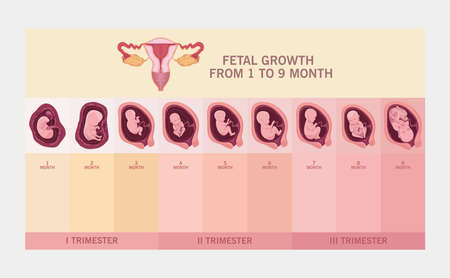The Real Deal on Sleep (Or, the Lack of It)
If you thought pregnancy insomnia was just a myth, welcome to your third trimester reality. At this stage, sleep can feel like an impossible luxury—thanks to a growing belly, constant trips to the bathroom, and an active baby who loves to practice karate at 3 a.m. Many American moms-to-be are surprised by just how tough it is to find a comfortable sleeping position. Side-sleeping with a fortress of pillows becomes the new normal, and even then, deep sleep can be hard to come by. Experts say that frequent waking is common and totally normal in late pregnancy, but that doesn’t mean it’s any less frustrating. To make the most of your shut-eye, try classic U.S. hacks: invest in a supportive body pillow, keep your bedroom cool and dark, limit caffeine after lunch, and wind down with calming routines like gentle stretches or reading before bed. Remember, you’re not alone—and sometimes, just knowing that other parents have been there makes those sleepless nights feel a little easier.
2. Unexpected Body Changes No One Warned You About
When it comes to the third trimester, most expecting moms in the U.S. hear plenty about baby kicks and nesting instincts, but far fewer are prepared for the less-glamorous physical changes that show up seemingly overnight. Swelling feet and ankles (hello, cankles!), sudden food aversions, and relentless back pain are just a few of the surprises that can turn daily life upside down. Let’s break down some of these common—yet rarely talked about—symptoms and how American moms-to-be manage them.
Common Physical Surprises in the Third Trimester
| Symptom | Description | How Moms Cope |
|---|---|---|
| Swollen Feet & Ankles | Fluid retention causes puffiness, especially after a long day on your feet. | Elevating legs, wearing compression socks, staying hydrated. |
| Food Aversions | Sudden dislike for foods you once loved—even those pregnancy cravings! | Opting for bland snacks, meal prepping with “safe” foods. |
| Nasal Congestion | Hormonal changes swell nasal passages, making breathing tough. | Using humidifiers, saline sprays, or sleeping propped up. |
| Back Pain | The growing belly shifts posture and strains muscles. | Prenatal yoga, warm compresses, supportive pillows at night. |
Coping in Everyday American Life
For many American moms-to-be, dealing with these symptoms means creative problem-solving. It’s not unusual to see a pregnant woman in sandals even in winter because her shoes no longer fit. Some keep extra snacks in their purse for unpredictable food aversions. Others rely on community support—whether it’s advice from their OB-GYN, prenatal fitness classes, or online forums like What To Expect or local Facebook groups—to swap tips and commiserate about these shared challenges.
A Word from Moms Who’ve Been There
If you’re feeling overwhelmed by all these changes, you’re definitely not alone. Most women find comfort in connecting with others going through similar experiences—and remember: there’s no such thing as a silly question when it comes to your health and comfort during pregnancy. Your body is doing incredible work, even if it sometimes feels like it’s working against you!

3. Emotions on a Rollercoaster
What no one really prepares you for in the third trimester is the emotional whirlwind that comes with it. You might find yourself laughing one minute and tearing up the next—for reasons that sometimes don’t make sense even to you. These mood swings are completely normal, thanks to fluctuating hormones, physical discomfort, and the looming anticipation of labor and parenthood. Anxiety about giving birth and caring for a newborn is common, even if this isn’t your first baby.
American moms-to-be often find comfort and strength in community-based support systems. Prenatal groups, whether held at local hospitals or community centers, provide a safe space to share fears, vent frustrations, and celebrate milestones together. There’s also growing awareness around prenatal counseling, where licensed therapists help expecting parents manage anxiety, process worries about labor, or talk through relationship changes. These resources aren’t just for those experiencing severe emotional distress—sometimes just having someone listen and validate your feelings makes all the difference.
If you’re feeling overwhelmed or unusually anxious, don’t hesitate to reach out for help. Many American healthcare providers proactively screen for mental health concerns during pregnancy checkups. Remember: Taking care of your emotional well-being is just as important as preparing your hospital bag or finishing the nursery.
4. It’s Not Just ‘Nesting’—Preparing for Birth Stateside
Sure, you might feel an irresistible urge to organize the nursery or deep clean your home—but third-trimester prep in America goes way beyond “nesting.” As your due date approaches, some practical steps can make your transition smoother and less stressful. Here are some key preparations that every mom-to-be should know about:
Hospital Bag Essentials: What Americans Actually Pack
Packing your hospital bag isn’t just about comfort—it’s about having everything you and your baby will need once labor starts. While some items are universal, American hospitals have their own quirks and conveniences. Check out this table of must-haves:
| Category | Recommended Items |
|---|---|
| For Mom | ID/Insurance card, birth plan, phone + charger, comfortable clothes, toiletries, snacks |
| For Baby | Going-home outfit, swaddle blanket, newborn hat, approved car seat (required for discharge) |
| Other Musts | Partner’s essentials, camera, list of people to notify |
Car Seat Installation: A Legal Must-Do
Unlike in many other countries, U.S. hospitals cannot let you take your baby home unless there’s an approved car seat installed in your vehicle. Many local police stations and fire departments offer free car seat installation checks. Double-check the manufacturer’s instructions and schedule a professional inspection if you’re unsure—peace of mind is priceless.
Choosing Your Pediatrician: Don’t Wait Until Delivery
Selecting a pediatrician before your baby arrives is more than a recommendation; it’s an expectation at most American hospitals. The staff will ask for your chosen doctor’s name so they can send newborn medical records directly. Ask friends for recommendations, verify insurance coverage, and consider office location and hours. If possible, set up a prenatal meet-and-greet to see if the practice fits your family’s needs.
Quick Checklist: Third Trimester Preparation To-Dos
- Pack your hospital bag by week 36
- Install and inspect your car seat ahead of time
- Select and register with a pediatrician
- Finalize childcare plans for siblings or pets
The Bottom Line
The third trimester is about more than cleaning closets—it’s about making thoughtful decisions that set you up for a positive birth experience in the U.S. By focusing on these practical steps now, you’ll be ready when it’s go-time—and able to enjoy those first moments with less worry.
5. Relationship Shifts with Your Partner
The third trimester is a time of anticipation, excitement, and—let’s be honest—a little bit of stress. What no one really tells you is how these final months before your baby arrives can impact your relationship with your partner. Whether it’s your first child or you’re adding to the family, pregnancy can bring about unexpected changes in the way you connect and communicate.
Understanding Emotional Changes
Hormones are running high, bodies are changing rapidly, and anxieties about parenthood often sneak up at night. It’s normal for couples in America to experience mood swings, misunderstandings, or even arguments over things that might have seemed minor before pregnancy. The third trimester brings unique pressures: physical discomfort, worries about labor, and the reality that your lives are about to change forever.
Communication is Key
Many American couples find that open communication becomes more important than ever during this stage. Scheduling regular check-ins—whether it’s a weekly coffee date at home or a quick walk around the neighborhood—can help you both share feelings, expectations, and concerns. Don’t shy away from talking about fears or frustrations; being honest helps build trust and keeps resentment at bay.
Keeping the Connection Strong
It’s easy to let romance take a back seat when you’re dealing with swollen ankles and endless doctor appointments. But couples who make an effort to nurture their bond often feel more supported heading into parenthood. Little gestures matter: leaving notes for each other, watching your favorite show together, or planning a special “babymoon” weekend (even if it’s just a cozy night in) can make all the difference.
Lean on Your Support System
Don’t hesitate to reach out for help or advice—from friends who’ve been there, family members, or even support groups designed for expectant parents. Many American communities offer prenatal classes that include relationship tips or counseling services specifically for new parents-to-be.
The truth is, every couple faces ups and downs during the third trimester. By acknowledging the changes and working together as a team, you’ll not only get through these last few weeks—you’ll lay a stronger foundation for life as a family.
6. Your ‘Village’ Matters More Than Ever
It’s true what they say—“it takes a village”—and in your third trimester, you’ll feel this more than ever before. What no one tells you is just how essential your support network becomes in these final weeks before baby arrives. Friends, family, neighbors, and even colleagues can make all the difference in how you handle the physical and emotional rollercoaster of late pregnancy.
The American Way: Rallying Your Community
In the U.S., rallying your “village” is almost a rite of passage for expectant parents. Baby showers aren’t just about cute gifts—they’re a chance to gather loved ones, receive advice, and create joyful memories. Meal trains are another beloved tradition, where friends sign up to bring nourishing meals after baby arrives, so new parents have one less thing to worry about. Don’t be shy about accepting help; people truly want to pitch in!
Tips for Building and Strengthening Your Support Network
- Start Early: Begin reaching out to your circle as soon as possible. Let them know when you’ll need help most—especially around your due date and postpartum period.
- Be Specific: People love clear direction! Whether it’s running errands, watching older siblings, or simply checking in on you, don’t hesitate to assign tasks.
- Virtual Connections Count: If loved ones live far away, set up regular video calls or online group chats for emotional support and encouragement.
- Lean Into Community Resources: Many American neighborhoods have mom groups or parenting classes—both virtual and in-person—that can offer guidance and camaraderie.
The Takeaway
You don’t have to do this alone. Your third trimester is the perfect time to lean on those around you—American style! Embracing your “village” not only makes things easier but also helps set the stage for a supported, joyful transition into parenthood.
7. The Truth About Labor Signs and When to Head to the Hospital
Everyone talks about the big moment when labor begins, but few tell you just how confusing those first signs can be. Real talk: contractions don’t always feel like the dramatic scenes in movies. For many women, early contractions may feel like dull period cramps, lower back pain, or a tightening across your belly that comes and goes. It’s not always easy to know if it’s the real thing or just Braxton Hicks “practice” contractions.
What Do Contractions Really Feel Like?
Contractions are usually described as waves of pain or pressure that start in your lower back and move to the front of your belly. In early labor, they might be mild and irregular—maybe even so gentle you’re not sure what’s happening. As labor progresses, they’ll get stronger, last longer (about 60 seconds), and come more regularly (about every 5 minutes).
How About Your Water Breaking?
Another myth: most women do NOT have their water break dramatically before labor starts. In fact, only about 10-15% experience that Hollywood-style gush. Often, it’s more like a slow leak or trickle. If you notice unexpected wetness that doesn’t stop, call your provider for advice.
When Should You Head to the Hospital?
In the U.S., most healthcare providers use the “5-1-1 rule” for first-time moms: contractions are five minutes apart, lasting one minute each, for at least one hour. If you’re having a high-risk pregnancy or live far from your hospital, your doctor may give different guidance. Always go in sooner if you have heavy bleeding, severe pain, decreased baby movement, or just feel something is wrong—trust your gut! And remember: you can always call your provider for reassurance and direction.
The bottom line? Labor often looks different than expected. Listen to your body, don’t hesitate to ask questions, and lean on your care team—they’ve seen it all and are there to help you through every step.


